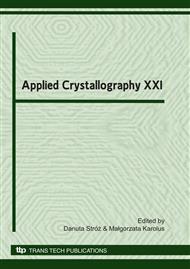p.264
p.268
p.272
p.278
p.282
p.286
p.291
p.295
p.299
Phase Transformation in Austenitic Steel Induced by Plastic Deformation
Abstract:
Kinetics of deformation induced martensitic transformation in metastable austenitic AISI 301 steel was characterized by several techniques including classical light metallography, X-ray diffraction, neutron diffraction and electron back scattered diffraction. In order to characterize the martensitic transformation, several specimens were tensile pre-deformed to 5%, 10% and 20% of plastic deformation and compared with non-deformed state. During straining, the volume fraction of α’-martensite rapidly prevails over the volume fraction of original austenite and reach the value circa 70%.
Info:
Periodical:
Pages:
295-298
Citation:
Online since:
June 2010
Authors:
Price:
Сopyright:
© 2010 Trans Tech Publications Ltd. All Rights Reserved
Share:
Citation:


